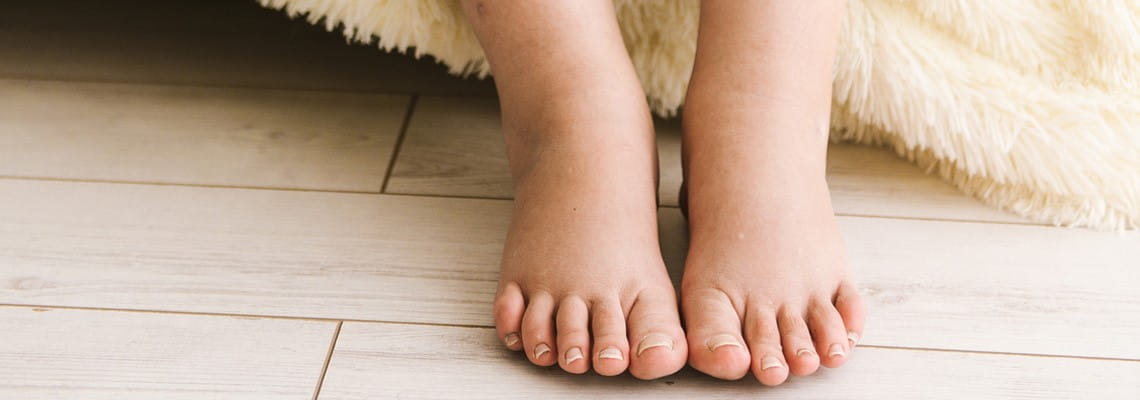Why Are My Feet & Ankles Swollen?

The puffy, tight, shiny skin that comes with having swollen feet and ankles isn't just noticeable, it's uncomfortable.
If it's happening frequently, it also may have you worried.
"Swelling in the lower legs — referred to as lower-extremity edema — can occur for a variety of reasons, some of which are more concerning than others," says Dr. Tony Lu, a vascular surgeon at Houston Methodist. "In certain cases, it can be a sign of an underlying health condition."
What causes swollen feet and ankles?
Swelling in the lower legs occurs when blood or fluid accumulates for one reason or another.
Sometimes you know why that might be — a salty meal, pregnancy, physical injury, standing or sitting for a long time.
But sometimes the causes of lower-leg swelling can be quite serious, reflecting issues within the circulatory system, heart or kidneys.
The underlying health conditions that can cause lower-extremity edema include:
- Venous insufficiency – when valves in the leg veins are worn down and less effective at sending blood back to the heart
- Lymphedema – when lymph fluid builds up because it cannot drain properly
- Heart failure – when the heart cannot pump blood as effectively as it should
- Kidney disease – when the kidneys cannot filter blood and remove excess fluid as effectively as they should
"Venous insufficiency often affects both legs, so the swelling it causes is typically seen in both feet and ankles," explains Dr. Lu. "This swelling tends to fluctuate over the course of the day, getting worse as the day progresses and then improving overnight."
Lymphedema, on the other hand, causes chronic swelling that persists throughout the day. It can also be asymmetric, meaning affecting just one foot or one leg.
"Heart failure causes swelling in both legs as blood begins to back up," explains Dr. Lu. "This swelling can come on suddenly — though it primarily happens in people with known heart issues, such as a history of heart attack."
Failing kidneys can lead to sudden swelling, too, as excess fluid collects any place it can. And this swelling isn't isolated to just the feet and ankles. Fluid can also accumulate in the hands and face.
Are swollen feet dangerous?
Minor lower-leg swelling that comes and goes isn't a huge concern. But if foot and ankle swelling is frequent, painful or persists for several weeks, it's important for consult your primary-care doctor.
For starters, swelling can come with complications — including wounds and even infection.
"Swelling stretches the skin, which itself can be uncomfortable," says Dr. Lu. "Eventually, this stretching can lead to breaks and tears in the skin. These wounds aren't just painful, they're nutrient-rich environments for bacteria to grow and cause infection."
Plus, if lower leg swelling is caused by an underlying health condition, the sooner you know, the better. There may be treatment options that can help reduce your symptoms.
"In the case of venous insufficiency, we can use ablation to permanently close the valves that are malfunctioning and leading to swelling," says Dr. Lu. "This reroutes blood flow through healthy veins in the leg so it can return to the heart unimpeded."
And some of the other causes of lower-leg swelling — heart failure and kidney disease — are serious health conditions that need to be addressed.
"Your primary care doctor can perform the lab work needed to evaluate how your heart and kidneys are functioning," explains Dr. Lu. "This can help rule out or confirm whether leg swelling is caused by an underlying condition that requires treatment."
Lastly, sudden swelling in just one leg can be a sign of deep vein thrombosis — when blood clots form deep inside veins of the legs. This is always something to mention to your doctor since it increases your risk of a blood clot breaking loose and causing a pulmonary embolism, which is a life-threatening emergency.
How to get rid of swollen feet
To alleviate swollen feet and ankles, Dr. Lu recommends elevation and compression.
"Both help redistribute blood or fluid, keeping it from accumulating in the legs," says Dr. Lu. "Movement and avoiding sitting or standing for long periods of time helps with this, too."
When it comes to compression, Dr. Lu recommends compression socks or stockings. But he warns against socks that stop at the ankle or leave the toes exposed.
"You want compression socks to come up to the calf area," Dr. Lu explains. "Otherwise the blood or fluid will simply collect at the ankle. Socks that leave openings for the toes pose a similar risk, causing swelling there."
Compression stockings and socks shouldn't be worn while you're asleep, he notes.
And though these home remedies are simple ways for anyone experiencing feet and ankle swelling to find relief, Dr. Lu stresses the importance of consulting your primary-care doctor if the issue persists.
"If elevation and compression aren't improving lower leg swelling, it's a sign that there's a larger issue at hand that needs evaluation and possibly treatment," adds Dr. Lu.
In some cases, treatment is needed to simply reduce your symptoms. In others, it's also needed to prevent the underlying health condition from progressing into a serious, life-threatening issue.
Oct. 28, 2022
